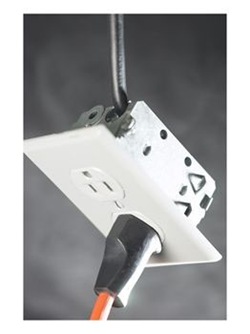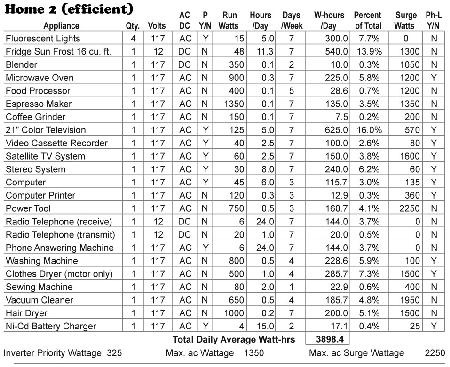1006 Morton Street
Baltimore, MD 21201
410.576.9131 | RW1haWw=
July 9 2008
What is (Plug) Load Analysis?
Plug analysis is a method of understanding the energy needs of an individual, family or group. It is an essential part is selecting, sizing, and designing an appropriate renewable energy system for a building. The method is especially significant because of the relatively high cost of many renewable energy systems. Sizing the system to meet needs ensures that no excess capacity is paid for in the system, it also provides a check to establish the needs of the building are adequately met.
?Every watt not used is a watt that doesn?t have to be produced, processed, or stored.? -Richard Perez, Home Power, March 1997
Plug analysis is done by creating a ?load profile.? Load profiles take into account all electrical equipment used in a building including: appliances, lighting, electronics, conditioning systems, as well as phantom loads associated with these devices. When a building is designed it is first important to consider whether or not there is a need for electricity at all in some appliances or systems. Hot water and heating for instance are very inefficient when electricity is used. Some home appliances can be bought which run on fuel sources besides electricity so the electrical requirements on the renewable energy and grid systems may not need to be as large. It must be noted that many electrical devices draw a significant amount of electricity when in use but these devices are often times used for very short periods of time and may be extremely efficient at their tasks. Microwaves for instance have heavy energy loads but run for only short periods and heat food very effectively and efficient.
?A good rule of thumb says that for every extra dollar spent on energy efficient appliances, three dollars will be saved in energy system components.? -Richard Perez, Home Power, March 1997
A load analysis must also include information such as occupancy, use, and behavior. The ?load profile,? when done correctly, will account successfully for these unique loading requirements. There are loads however that are not as clearly defined as those on the sticker at the device. These phantom loads are usually small power draws on the overall system but add up to large loads because they run continuously even while the device is switched off. Phantom loads are common in such devices as televisions and microwaves. In the case of TVs the load is generally used to keep the tube warm and ready for the remote control to switch the device on, in these cases it is referred to as a ?quick startup load.? Microwaves and all other devices which have built in clocks use phantom loads to operate the digital clock and other lights or buttons even while the device is not is use. Phantom loads can be hard to quantify but are relatively easy to identify. An ammometer can be used to measure the draw from such devices. Alternatively by simply unplugging the device or using a power strip with a switch on it will cut all power and remove the constant load.
A load analysis can be done easily by using charts such as the one provided by Home Powwer magazine at www.homepower.com. To complete the spreadsheet, every appliance, device and light in the building must be noted. The end result will be a total daily kWh usage for the building. Home Power has the following advice:
?Try to be realistic about your lifestyle and energy usage habits... Americans watch twice as much TV as they think they do.? -Richard Perez, Home Power, March 1997
On the following page is an example of a load analysis chart. Filling out the chart is simple but it is very important to understand the exact data to enter into the spreadsheet. Column A is simply asking for the name of the appliance or device being listed. In the case of phantom loads they should be listed as a separate line item in the chart. Lights need not be listed individually, rather it is suggested that a per person light usage is assumed and only that number of bulbs is input. Column B asks for the number of appliances used. Column C asks for the load voltage. Most appliances run at 110 volts (117 volts rms). This information is available from the EnergyStar website or on the sticker attached to the device. Column D wants to know if the appliance uses AC or DC power. Energy produced by the PV system is in DC form and some appliances are available in Direct Current form to aid in preventing excess inverter losses inherent in the conversion from DC to AC. Column E simply wants to know if the device is on a lot or needs access to power. This is called Inverter Priority. All appliances that run in cycles or turn themselves off and on must be set to have Inverter Priority. Column F is related to the Run Watts consumed when the device is in operation. Most electrical appliances list their energy consumption, but the device power draw can always be calculated by directly measuring the measure the amps and multiply by 117 volts to determine the watts. Stickers listing wattage are for peak loads and can usually be discounted by 25% and still be accurate. Column G needs to know how many hours per day the appliance is being used. Column H asks the user to specify the number of days per week the appliance is used. These last two columns are included to help incorporate behavioral deviation into the calculation. Columns I outputs the total Watt-Hours per day for that given appliance based on previous input. Column J shows the percentage of total electricity use for the entire system of the given appliance. Column K asks if there is a starting surge. The starting surge is present in many devices that run motors which start under a load. The start surge can be as high as three to seven times the rated run wattage of the appliance. The affect of the surge watt is minimal however on the overall performance of the house because of its speed. Column L asks if there is a phantom load produced by the device.
The most crucial information is listed in Column I at the bottom of the chart. This is the number used to size the system!
Recent Posts
Reimagining Harborplace to Create Space for Both Private Development and Expanded Public Space » Lawyer's Mall Reconstruction Progress » Confronting the Conventions of Customary Practice » Reconceived Facades: New Roles for Old Buildings » Ivy Bookshop Opens for Business! »
Categories
Yellow Balloon Baltimore » Products + Technology » Industry + Practice » Other » Architecture »
Links
Organizations
- USGBC Baltimore Regional Chapter »
- AIA - American Institute of Architects »
- USGBC »
- The Walters Art Museum »
- Green-e »
- Center for Building Performance and Diagnostics (CMU) »
- Green Globes »
- Prefab Lab (UT) »
- Center for Sustainable Development (UT) »
- Architecture 2030 »
- Bioneers »
- Street Films »
- FreeCycle »
- Chesapeake Bay Foundation »
- Archinect »
- BD Online - The Architects Website »
- National Wildlife Foundation »
- Natural Resources Defense Council »
- Overbrook Foundation »
- Merck Family Foundation »
- Ecology Center »
- New Building Institute »
- Neighborhood Design Center »
- The Leonardo Academy »
- ZigerSnead Architects LLP »
- The Rocky Mountain Institute »
- Urban Habitats »
- ACORE - American Council on Renewable Energy »
- Parks and People Foundation of Baltimore »
- Open Society Institute of Baltimore »
- Natural Capital Institute »
- Passive House US »
- Svanen Miljomark »
- Green Restaurant Association »
- Rocky Mountain Institute »
- Green Exhibits »
- Green Roundtable »
- John Elkington - SustainAbility »
- SustainAbility »
- Building America »
- Endangered Species Program - Fish and Wildlife Service »
- Congress for the New Urbanism »
- Urban Land Institute »
- Cool Roof Rating Council »
- Montgomery County (MD) Public Schools Green Building Program »
- National Institute of Standards and Technology Software »
- Scientific Certification Systems »
- Community Greens »
- CBECS »
- CASE - Center for Architecture Science and Ecology »
Interesting Sites
- The Ecologist »
- Treehugger »
- Grist »
- WIRED »
- Planet Architecture »
- MiljoBloggAktuellt - Environmental News Blog (Swedish »
- Sustainable Design Update »
- Eikongraphia »
- World Architecture News »
- The Cool Hunter »
- Design Center »
- ZEDfactory »
- Architen Landrell Associates Ltd. »
- Environmental Graffiti »
- businessGreen »
- Best Green Blogs Directory »
- Groovy Green »
- EcoGeek »
- Urban Ecology »
- Locus Architecture »
- Urbanite »
- A Daily Dose of Architecture »
- Adaptive Reuse »
- Audacious Ideas »
- Big Green Me »
- NOTCOT »
- Sustainable Baltimore »
- Thoughts on Global Warming »
- Green Maven »
- WorldChanging »
- Go For Change »
- Building Green »
- Home Energy Magazine »
- Home Energy Blog »
- FEMA Map Service- Federal Emergency Management Association »
- Architectural Graphic Standards »
- E-Wire »
- Post Carbon Cities »
- Alt Dot Energy »
- Whole Building Design Guide »
- B'more Green »
- EJP: Environmental Justice Partnership »
- Baltidome »
- OneOffMag »


July 9th, 2008 at 5:21 AM
McBuild » Blog Archive » What is (Plug) Load Analysis?
[...] Plug analysis is a method of understanding the energy needs of an individual, family or group. It is an essential part is selecting, sizing, and designing an appropriate renewable energy system for a building. The method is especially …Posted from By jonasrisen [...]